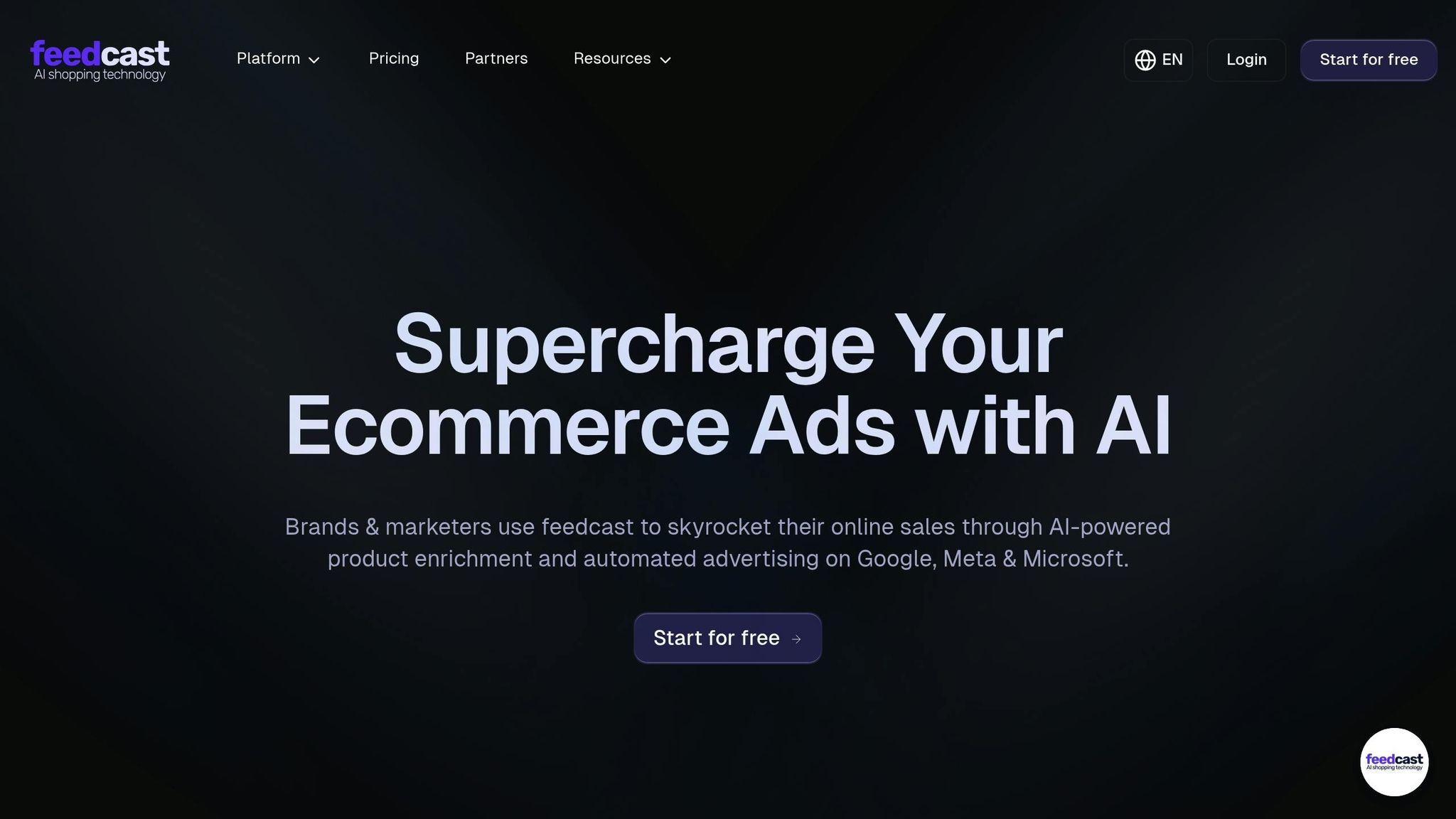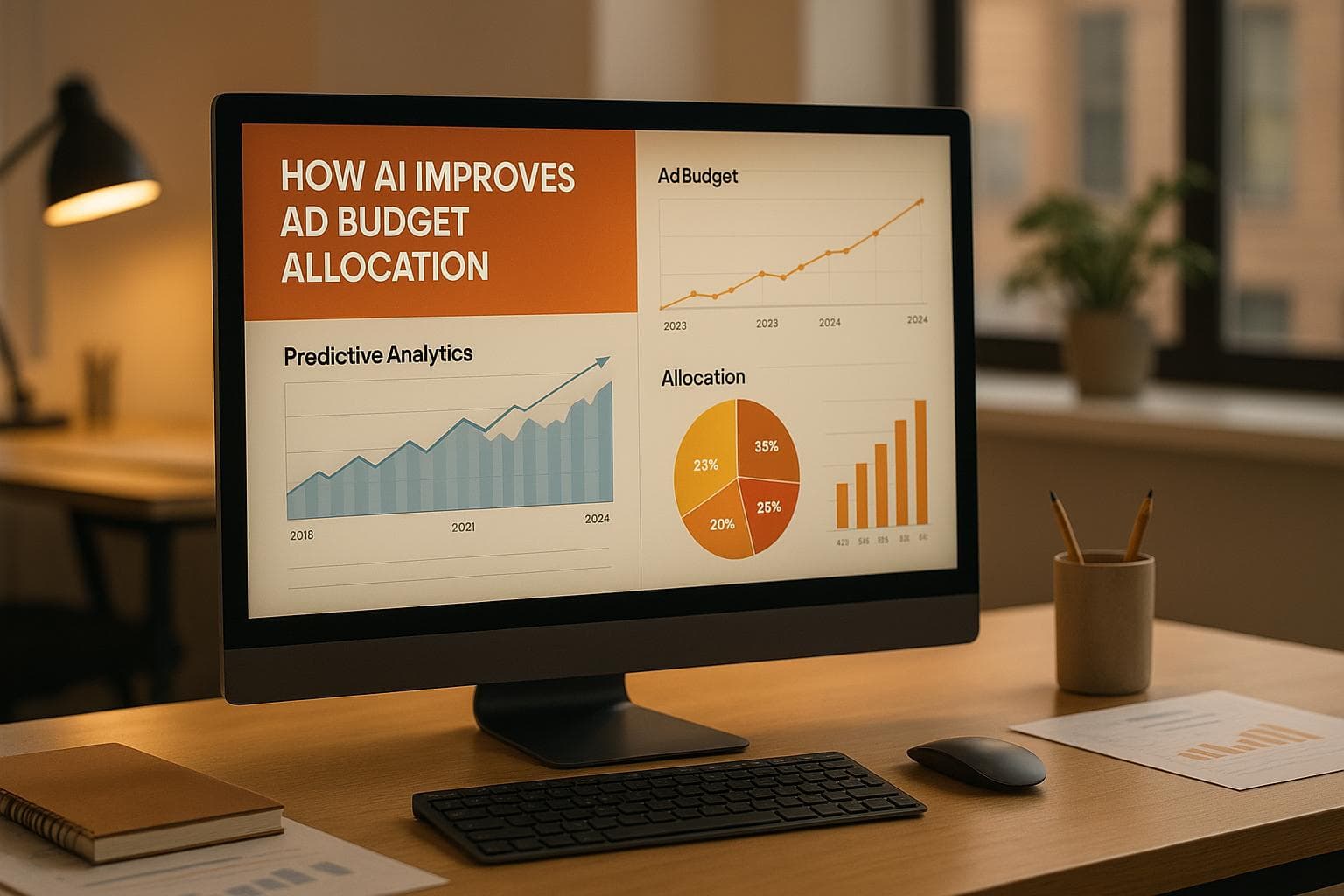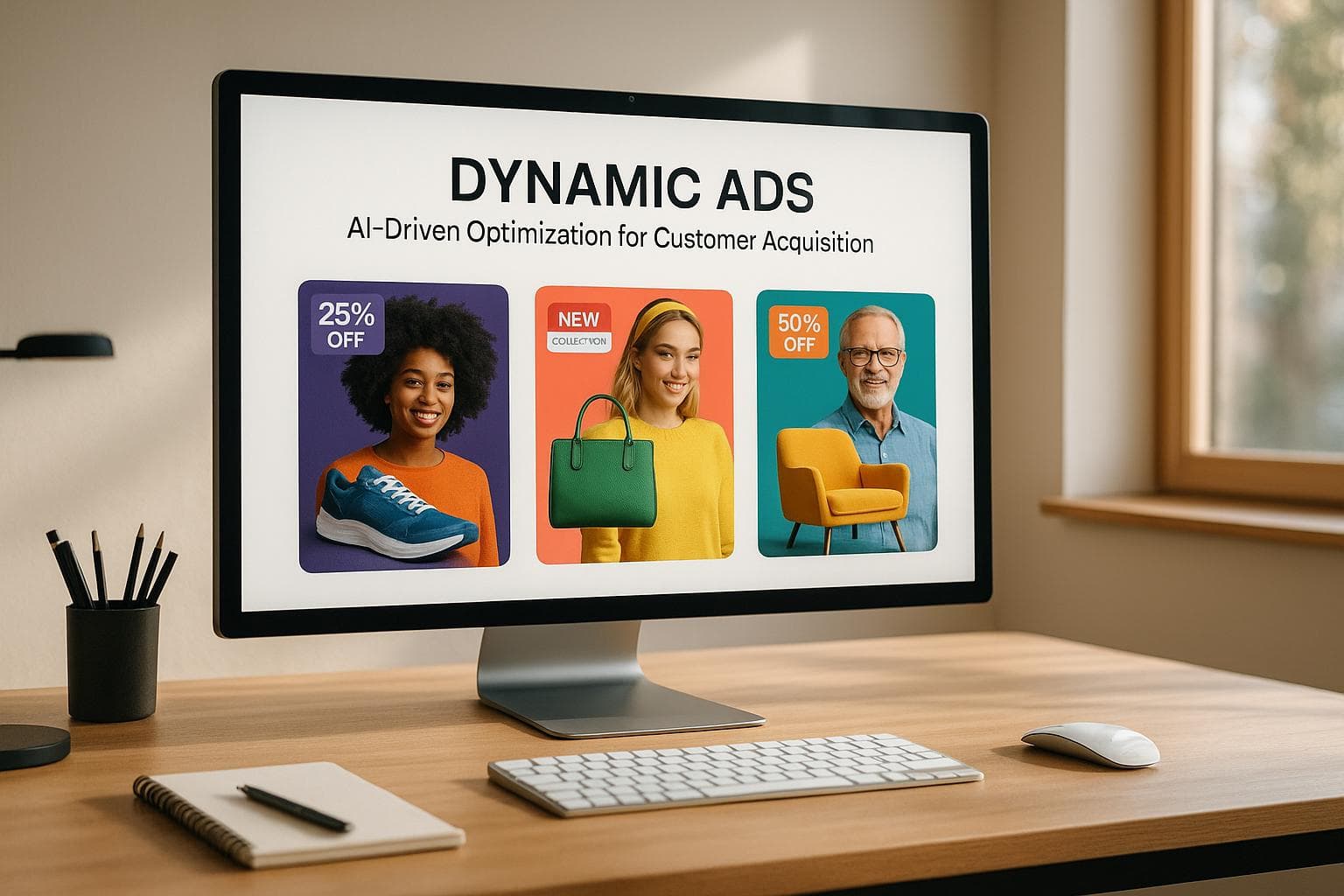How AI Improves Ad Budget Allocation
Learn how AI enhances ad budget management with real-time adjustments, predictive analytics, and improved ROI for e-commerce businesses.
AI is changing how businesses manage ad budgets by replacing manual processes with data-driven automation. Here's what you need to know:
- Real-Time Adjustments: AI reallocates ad spend instantly based on campaign performance, reducing wasted funds.
- Predictive Analytics: By analyzing past data, AI predicts which channels and audiences will perform best, helping businesses focus on high-value opportunities.
- Better Attribution: AI tracks customer behavior across platforms, providing a clearer picture of what drives conversions.
- Proven Results: Companies using AI report up to 40% higher ROI, 30% lower customer acquisition costs, and increased revenue.
Platforms like Feedcast.ai simplify these processes, offering tools for small and large businesses to manage ads across Google, Meta, and Microsoft Ads. AI ensures every dollar works harder, making it essential for competitive e-commerce advertising.
Meet Media Mix Mary: The AI Agent Optimizing Ad Performance
How AI Improves Budget Allocation: Methods and Benefits
AI takes ad budget allocation to the next level by enabling real-time, data-driven decisions that adjust instantly to shifting market dynamics. Here's a closer look at how AI optimizes this process and the benefits it brings.
Predictive Analytics for Smarter Allocation
AI leverages historical data, customer behavior insights, and market trends to predict which channels, audiences, and ad formats will deliver the best results [2]. By using machine learning models, it can estimate conversion rates and customer lifetime value, allowing businesses to proactively allocate budgets to the most promising segments. For instance, AI uncovers patterns like seasonal fluctuations or demographic preferences that might otherwise go unnoticed. A great example? An automotive brand saw a 15% increase in click-through rates and a 25% boost in lead generation by tapping into these predictive tools [2].
Real-Time Adjustments for Optimized Spending
AI systems monitor campaign performance continuously, enabling real-time budget adjustments. This means funds can be reallocated between campaigns, channels, or audience segments without delay. By doing so, businesses can maximize returns, avoid wasting resources on underperforming ads, and quickly seize new opportunities [3]. Unlike traditional approaches that rely on periodic reviews, AI ensures decisions are made with up-to-the-minute data.
Attribution Modeling for Deeper Insights
AI-powered attribution modeling digs into customer interactions across multiple channels, assigning value to every touchpoint [2]. Unlike outdated last-click models, this method highlights the role of earlier, top-of-funnel activities, giving advertisers a complete picture of how different channels work together to drive conversions. For example, these insights can show how one platform builds brand awareness while another seals the deal. A consumer goods company that adopted AI-based real-time ad optimization reported a 40% jump in campaign ROI and a significant boost in brand engagement [2].
Case Studies: How AI Impacts Ad Budget Allocation
Real-world examples highlight how AI transforms ad budget allocation, delivering measurable results across various industries. Companies leveraging AI-powered tools often report improved returns on their ad spend and streamlined processes.
Measurable Improvements in ROI and Efficiency
A digital marketing agency implemented AI-driven budget pacing to adjust daily spending based on performance data. The results were impressive: a 20% revenue increase in the first month and an additional 10% boost in the second month. Beyond the financial gains, the agency saved significant time by automating manual tasks and gained real-time insights into campaign performance [3].
AI's ability to reallocate funds toward high-performing segments in real time helps minimize wasted spend. This automated approach not only reduces manual errors but also ensures ad dollars are directed toward strategies that deliver the best outcomes. The benefits of AI-driven budget allocation extend across industries, proving its versatility and effectiveness.
Examples from E-commerce and Beyond
Case studies consistently show that AI doesn't just optimize spending - it enhances overall campaign performance.
- In February 2024, an e-commerce retailer reduced customer acquisition costs by 30% while increasing conversion rates by 20% within three months of adopting AI-driven ad spend optimization [2].
- The automotive sector has also seen success. In January 2024, an automotive company used AI-powered channel optimization tools, achieving a 15% increase in click-through rates and a 25% boost in lead generation over two months [2].
- A consumer goods brand adopted AI for real-time ad optimization in March 2024, resulting in a 40% improvement in campaign ROI and stronger brand engagement over a single quarter [2].
These examples underline AI's role in more than just cost savings. By enabling precise targeting, better timing, and accurate performance tracking across multiple channels, AI-powered budget allocation consistently enhances ROI, strengthens brand engagement, and improves customer acquisition efficiency - regardless of the industry or company size.
sbb-itb-0bd1697
Feedcast.ai: AI-Powered Ad Budget Management Made Simple

Feedcast.ai takes the complexity out of ad budget management, offering a platform that works for businesses of all sizes. With over 3,000 e-commerce brands using its services, Feedcast.ai automates the intricate process of budget allocation, making advanced AI tools available to even the smallest retailers - no technical expertise required.
AI-Driven Multi-Channel Advertising
Running campaigns across multiple platforms can be a logistical headache. Feedcast.ai streamlines this process by integrating major advertising channels - Google, Meta (including Facebook and Instagram), and Microsoft Ads - into a single platform. Its AI doesn’t just automate; it personalizes. It creates tailored ad copy for each platform and reallocates budgets in real time, ensuring funds flow to the campaigns delivering the best results. By identifying high-value customer segments, it optimizes targeting for both new leads and existing customers, maximizing every ad dollar.
Smarter Product Feed Management
When it comes to ad performance, high-quality product data is key. Feedcast.ai uses AI to enhance product titles, descriptions, and attributes automatically, ensuring that your ads are optimized for every platform. The platform integrates effortlessly with popular e-commerce tools like Shopify, WooCommerce, and Prestashop, and supports formats such as Google Sheets, CSV, and XML. By continuously monitoring and refining product feeds - and catching errors before they become costly - Feedcast.ai helps improve click-through and conversion rates by ensuring your ads reach the right audience.
As a certified Google CSS (Comparison Shopping Service) partner, Feedcast.ai can reduce Google Shopping campaign costs by up to 20% compared to standard Google Shopping ads. These savings, combined with optimized feeds, contribute to more efficient budget use and better campaign results.
Unified Dashboard and Real-Time Insights
Feedcast.ai’s unified dashboard brings all your performance data together in one place. Real-time metrics from every channel are consolidated, giving you a clear view of what’s working. With custom reporting and segmentation options, you can dive deep into campaign performance, product success, and audience behavior. This centralized setup supports quick, informed decision-making, allowing you to adjust budgets instantly when performance trends shift.
For businesses of all sizes, Feedcast.ai offers flexible pricing. There’s even a free tier with unlimited products and access to the unified dashboard. Paid plans start at $119 per month (approximately €99), making advanced AI-driven budget management an option for smaller retailers looking to stay competitive.
Tips for U.S. E-commerce Advertisers Using AI
To get the most out of AI in your advertising efforts, it’s crucial to set a strong foundation. These tips will guide you in integrating AI tools effectively into your existing workflows while steering clear of common mistakes. Below, we’ll explore three key strategies to help you make the most of your ad budget with AI.
Start with High-Quality Data
AI thrives on accurate, well-organized data. If your product catalog includes incomplete descriptions, inconsistent titles, or outdated pricing, AI systems won’t be able to make informed decisions about budget allocation. Poor data quality can lead to wasted ad spend and missed opportunities.
Before diving into AI, conduct a thorough audit of your product data. Eliminate duplicate entries, standardize naming conventions, and ensure all essential details - like descriptions and pricing - are complete. This kind of preparation pays off. For example, in 2024, a U.S. e-commerce retailer optimized its product data before implementing machine learning for ad budgets. The result? A 30% drop in customer acquisition costs and a 20% boost in conversion rates[2].
AI tools can also help streamline this process. Automated data enrichment platforms can refine product titles, descriptions, and attributes across your advertising channels, improving your reach to the right audiences. But remember, even the most advanced AI can’t compensate for bad data. Starting with clean, reliable data ensures your campaigns are built on solid ground.
To keep your data in top shape, make regular maintenance a habit. Schedule monthly reviews to catch errors like missing product images or incorrect pricing before they affect campaign performance. Many AI platforms even offer error detection features to help you spot and fix these issues quickly.
Once your data is in order, you’ll be better positioned to let AI amplify your advertising strategy.
Use AI to Support Your Current Efforts
AI works best when paired with human expertise. The most effective advertisers use AI to handle repetitive tasks and uncover insights, while they focus on steering campaigns strategically.
For instance, in May 2023, a digital advertising agency leveraged AI to automate daily budget adjustments. The result? Campaigns hitting their targets jumped from 50% to 83%, and revenue increased by 20% in the first month, with an additional 10% growth in the second month[3].
AI can take on the heavy lifting, such as analyzing large datasets, spotting performance trends, and making real-time bid adjustments. This frees up your team to focus on creative tasks like refining brand messaging or interpreting AI-generated insights within the larger context of your business goals. For example, while AI might suggest reallocating budget from one channel to another based on performance, it’s up to you to weigh factors like seasonal trends or brand awareness objectives that the algorithm might not fully grasp.
Ease into AI adoption by starting small. Use it for specific tasks like automated bidding or audience targeting, and expand its role as you grow more comfortable with the technology. This gradual approach allows you to retain control while discovering how AI can enhance your unique business needs.
Remember, AI is a tool - not a replacement for your expertise. A balanced approach ensures you get the best of both worlds.
Monitor and Adjust Regularly
AI isn’t a set-it-and-forget-it solution. While algorithms can adapt to changing conditions, they still need human oversight to align with your business goals.
Set up tracking systems that provide clear visibility into performance across all channels. At a minimum, review metrics like cost per acquisition, conversion rates, and return on ad spend weekly. For high-volume campaigns, daily monitoring is even better. This vigilance allows you to identify trends and determine whether they’re temporary fluctuations or signs that your strategy needs adjustment.
For example, a consumer goods brand that used AI-driven tools for real-time ad optimization in 2024 achieved a 40% increase in overall campaign ROI by consistently monitoring and fine-tuning their efforts[2].
To stay ahead, set alerts for major performance changes. If your AI suddenly increases spending on a campaign, dig into the reasons. Is it responding to a trending topic, or is there a glitch causing overspending? Quick action in these situations can mean the difference between seizing an opportunity and wasting your budget.
Keep in mind that AI provides recommendations, not final decisions. Always consider broader factors like inventory levels, seasonal demand, and your competitive landscape when making adjustments. By combining AI insights with your strategic judgment, you can ensure every advertising dollar delivers maximum impact. Regular, real-time adjustments will keep your campaigns sharp and effective, reinforcing the advantages AI brings to the table.
Conclusion: How AI Changes Advertising
AI has completely reshaped how e-commerce businesses manage their ad budgets, replacing guesswork with precise, data-driven strategies. This shift has a direct impact on profit margins.
For example, one digital agency using AI-powered budget monitoring saw campaign alignment jump from 50% to 83%, resulting in a 20% increase in first-month revenue[3].
Beyond these measurable improvements, real-time optimization takes ad spending to the next level. Instead of waiting days - or even weeks - to tweak budgets, AI systems keep a constant eye on performance, reallocating funds to the most effective channels and audiences. This level of responsiveness ensures every advertising dollar is maximized, whether by spotting new trends or quickly cutting back on campaigns that aren't delivering results.
Platforms like Feedcast.ai make these capabilities available to businesses of all sizes. With features like unified multi-channel management, AI-powered product feed optimization, and detailed analytics all in one dashboard, the platform simplifies the complexities of traditional ad management. Plus, as a certified Google CSS partner, it can help businesses save up to 20% on Google Shopping campaigns[1], making ad budgets stretch even further.
For U.S. e-commerce businesses, the message is clear: adopting AI tools isn't just an option - it's a competitive necessity. Rather than replacing human expertise, AI enhances it, freeing up marketers to focus on strategy while algorithms handle the heavy lifting of budget optimization.
The momentum is undeniable. Over 3,000 e-commerce brands are already leveraging Feedcast.ai to elevate their advertising performance[1]. As these tools grow more advanced and accessible, the question isn’t whether businesses should integrate AI - it’s how quickly they can do so to stay ahead. AI is not just transforming budget allocation; it's driving innovation across the entire digital advertising landscape.
FAQs
How does AI help lower customer acquisition costs and boost ROI in advertising?
AI simplifies advertising by refining product data to boost visibility and implementing smart targeting to connect with new customers or re-engage past ones. This approach helps lower customer acquisition costs while strengthening customer loyalty and retention.
With advanced tools for performance tracking across various ad channels, businesses can rely on data-driven insights to fine-tune their strategies, improve ROI, and enhance campaign efficiency. By automating and centralizing these efforts, AI saves advertisers both time and money.
How does real-time data enhance AI-driven ad budget allocation compared to traditional methods?
Real-time data plays a key role in how AI manages ad budget allocation. It enables instant adjustments based on current performance metrics and shifting market conditions. This is a major step up from traditional methods, which often depend on historical data and manual tweaks. With AI, budgets are dynamically directed to the most effective channels, ensuring the best possible return on investment (ROI).
Take platforms like Feedcast.ai, for example. By tapping into real-time data, they can fine-tune campaigns on the fly, sharpen targeting, and boost overall ad performance. For e-commerce businesses, this means staying ahead in fast-moving markets while getting the most out of every advertising dollar.
How can businesses use AI tools in their advertising strategies while staying in control of campaign decisions?
To effectively incorporate AI into advertising strategies while keeping control firmly in hand, businesses can turn to platforms like Feedcast.ai. This solution streamlines multi-channel advertising by bringing campaign management under one roof, automating repetitive tasks, and fine-tuning performance.
With features such as product data enrichment, intelligent targeting, and real-time performance monitoring, Feedcast.ai allows businesses to stay on top of their campaigns. By leveraging AI, companies can boost efficiency, improve ROI, and make smarter, data-driven decisions - all without sacrificing control. It's a way to simplify advertising while keeping everything running smoothly.
Yohann B.










